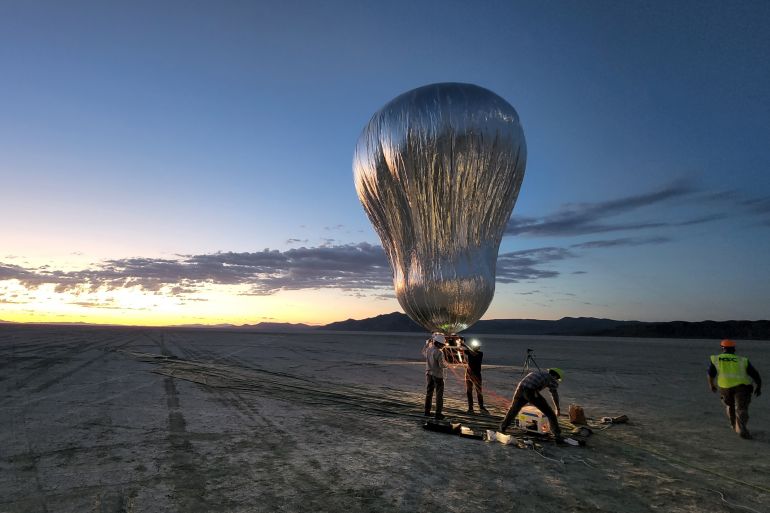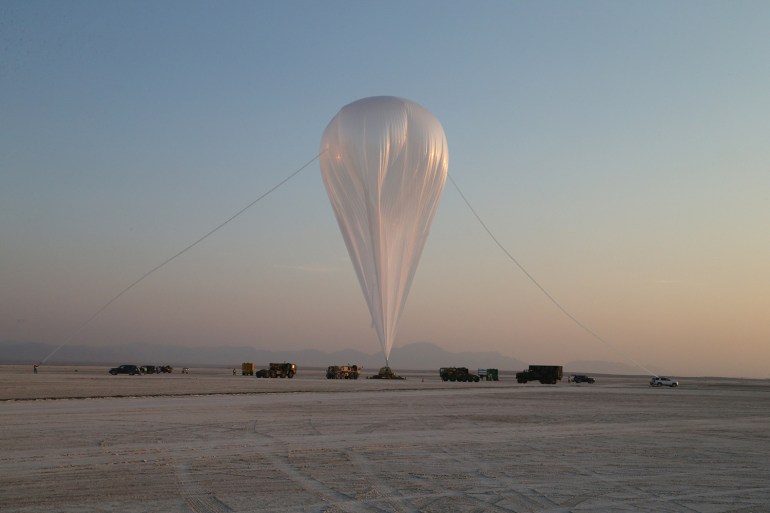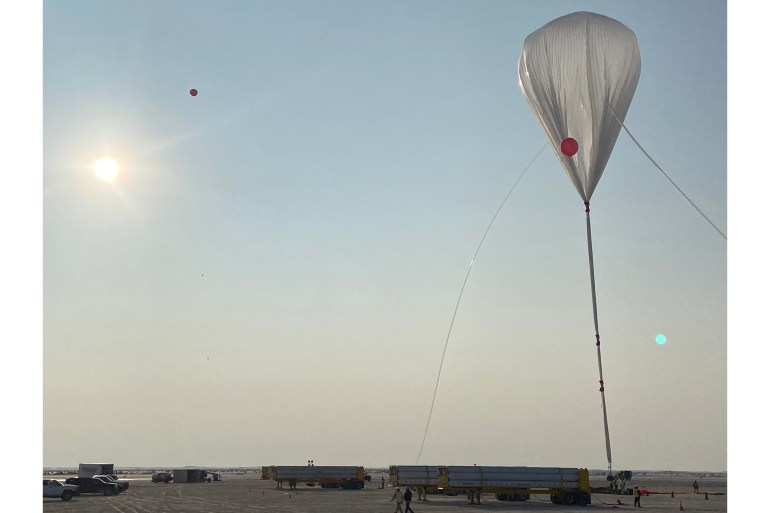Balloons, ‘objects’ – what’s in the sky above the US?
US airspace is increasingly crowded, not all of it is regulated, and with so much up there, it’s not easy to track it all.

Los Angeles, California – The United States military shot down a flurry of objects this month: a large object it identified as a Chinese surveillance balloon followed by three smaller objects that the government said might be “benign”.
The airborne objects were drifting through airspace increasingly crowded with commercial and amateur balloons, drones and possible aerial surveillance craft belonging to adversaries. Their rising numbers pose a challenge to aviators and government agencies. Experts say that while heavy commercial balloons must meet strict Federal Aviation Administration (FAA) regulations, lighter amateur balloons are exempt from most rules, and the FAA might not be able to track them.
Keep reading
list of 4 itemsBiden says US not seeking conflict with China after balloon saga
Balloon ‘panic’ intensifies push against China in Washington
Blinken says US to share info on alleged spy balloon with allies
Military and intelligence officials found no evidence that the three smaller objects were conducting surveillance for another country, and they were not sending communication signals, National Security Council spokesman John Kirby said at a White House briefing on Monday.
The three smaller objects may be operated by private companies or researchers although no one has claimed them, Kirby said. He ruled out extraterrestrials: “I don’t think the American people need to worry about aliens with respect to these craft. Period.”
US shoots down ‘objects’
In January, the US spotted a 60-metre-tall (200-foot-high) object it identified as a Chinese surveillance balloon. China said it had launched the device but it was a weather balloon. The US monitored the balloon as it travelled about 18,000 metres (60,000 feet) over Alaska, Canada and then to Idaho. On February 4, as it drifted off the coast of South Carolina, the US military shot it down over shallow waters about 13 metres (45 feet) deep. The US navy is working to recover the debris.
Days later, the US shot down three smaller objects. “We’re calling them objects, not balloons, for a reason,” General Glen VanHerck, head of North American Aerospace Defense Command, or NORAD, told reporters.
On Friday, US jets shot down a car-sized object flying at 12,000 metres (40,000 feet) over the Arctic Ocean near Alaska. The following day, jets shot down another “cylindrical” object at the same altitude over the Yukon. Canada’s defence minister, Anita Anand, said it was smaller than the Chinese surveillance balloon. And on Sunday, jets shot down a third object with an “octagonal” shape soaring at 6,000 metres (20,000 feet) over Lake Huron.
The recent events are not isolated. In February 2022, the US said it had detected a high-altitude unmanned balloon over the Hawaiian islands and sent aircraft to intercept it.
What are the various objects in the sky?
Most objects found in US airspace fly under 12,000 metres, including commercial and private jets, helicopters, recreational balloons that float customers over landscapes and blimps hovering above sports events, said Iain Boyd, director of the Center for National Security Initiatives at the University of Colorado. Drones and air taxis are also entering the mix.
Above 12,000 metres, there are few flying objects, Boyd told Al Jazeera. “There’s a lot of empty space in the atmosphere until you leave the atmosphere and go into space,” he said.
The balloon spotted by the US in late January was drifting in that region. Boyd said its size meant it was too large to be the weather balloon China said it was.
Weather balloons are a maximum of 6 metres (20 feet) across, according to the Weather Channel. The US National Weather Service releases weather balloons twice a day from 900 locations around the world, and 92 of those are released in the US. The balloons reach high altitudes of 30,000 metres (100,000 feet) and can drift 200 kilometres (125 miles). After two hours, the balloons burst and drift back to Earth with a parachute.

The FAA manages the various aircraft in US airspace, Boyd said. FAA rules apply to the entire National Airspace System, so there is no “unregulated” airspace, according to the agency.
High-altitude balloon experiments
While weather services launch balloons every day, there are relatively few high-altitude balloons launched by companies for scientific research in the US, said Kevin Tucker, president of Near Space Corporation, an aerospace company in Oregon. “Larger balloons like the kinds we use and several other companies as well as NASA in the United States are less frequent,” he said.
Near Space launches balloons that bring test equipment to heights of 30,000 metres, which is at the outer limits of our atmosphere while still within Earth’s gravitational pull. Winds above 12,000 metres are forecastable so the flight paths of these balloons are “fairly predictable”, he said.
The company recently launched a balloon for the European Space Agency’s Mars project that carried a surrogate rover to high altitudes to test its parachute system at atmospheric pressures similar to those found in the Martian atmosphere.
To launch a balloon, Near Space Corporation must comply with the US Code of Federal Regulations and policies set out by NASA and the FAA, Tucker said. Near Space files its flight plans with the FAA and coordinates the entire launch, ascent and descent with the agency. Like commercial aircraft, each balloon carries a transponder that allows the FAA to constantly track its position.
“The amount of planning and coordination for a flight is significant, arguably even more than to take off and land again in an airplane,” Tucker said.
“There’s quite a bit of responsibility taken by the people and operators here in the United States, and that’s what keeps these from being problematic,” he said.
Near Space is planning balloon launches for NASA experiments but hasn’t changed what it is doing in response to the military shooting down objects. “We’re continuing in our preparation for those and coordination with the FAA – just normal practice and, otherwise, no real changes,” Tucker said.
Unidentified objects
The US tracks and categorises unidentified objects too.
In 2022, the Department of Defense formed the All-domain Anomaly Resolution Office to begin analysing, identifying and reporting “unidentified anomalous phenomena” (UAPs) – anything in space, the air or sea that can’t be identified and that might pose a threat to US military operations.
UAP events are happening in restricted or sensitive airspace, raising safety issues for pilots in increasingly cluttered airspace and concern that the objects could be conducting surveillance for adversaries, according to a 2022 report by the Office of the Director of National Intelligence.
The report found that of 366 newly identified UAPs, 163 were balloons or ‘balloon-like entities’, 26 were unmanned aircraft systems and six were clutter, such as birds, weather events or airborne debris like plastic bags.
According to a report by the Department of Defense Unidentified Aerial Phenomena Task Force, there are five types of UAPs: “airborne clutter, natural atmospheric phenomena, USG or U.S. industry developmental programs, foreign adversary systems, and a catchall ‘other’ bin”.

The New York Times has reported that, according to a classified report to Congress in January, at least two incidents at US military bases could be attributed to advanced aerial technology by adversaries conducting surveillance. The incidents involved balloons and quadcopter drones, it reported.
FAA can’t track all balloons
FAA regulations allow amateur enthusiasts to launch balloons, according to Matthew Nelson, president of the Stratospheric Ballooning Association, a non-profit organisation in Iowa that encourages high-altitude ballooning. Its members are mostly academics.
The balloons they launch weigh about three kilogrammes (six pounds) and are a maximum 12 metres (40 feet) in diameter. Nelson said the group encourages members to notify the FAA two days in advance of a launch.
He explained that lighter balloons are exempt from many FAA rules. For example, a balloon carrying a payload under 1.8 kilos (four pounds) is exempt. “And if you’re flying multiple payloads, or items, then you can go up to 12 pounds [5.5 kilos],” he said.
While heavier commercial balloons carry transponders so the FAA can track them, Nelson said lighter amateur balloons don’t usually carry transponders. Instead, to meet FAA rules, they attach metallic material that reflects the radar signals from airports, allowing air traffic controllers to see the balloon’s position.
But if balloons are moving slowly, radar might not pick them up. “Depending on how the air traffic controller has the radar configured, they might be filtering out some of the slow moving stuff, so they may not see it on there, which is why we try to be in constant communication with them,” Nelson said.
After the US shot down a Chinese balloon and three other objects, his group is considering how to increase communication with authorities.
“For a long time, this has never been an issue,” Nelson said. “We’ve always been able to do these flights, and there’s been no concern about shutting it down. Obviously right now, tensions are a bit high, and it’s on everyone’s mind right now.”
“We’re definitely thinking about what we can do to ensure that authorities know what’s going on, and I think the biggest thing we can do is transparency and [ensuring] that we are communicating.”